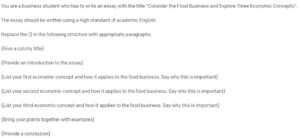This post may be controversial as it demonstrates how students can use Open AI’s GPT-3 language model to generate text for essays and assignments.
I’m sharing this simply because students already know this technology exists and are generating essays with it. The essays are not perfect, but you can produce text that appears well-written, at least on a superficial level.
You can see more detail in this video where I demonstrate some techniques working with the Open AI Playground functionality. There are companies out there that are essentially taking this technology, putting a neat front end on it, then charging people substantial amounts for using it. You can get better (and cheaper) results by working with the underlying system.
Here is a short essay (only 421 words long) I created live on the video. It is on a subject I know very little about.
The Three Biggest Economics Concepts in the Food Business
The food business is a huge and complex industry that is vital to our everyday lives. Understanding the economics behind it can help us make better decisions about what we eat and how we produce food. There are three key economic concepts that are particularly relevant to the food business: supply and demand, opportunity cost, and economies of scale.
Supply and demand is a basic concept of economics that refers to the amount of a good or service that is available compared to the amount that people want to buy. In the food business, supply and demand affects everything from the price of food to the types of food that are produced. For example, if there is high demand for organic food but low supply, then the price of organic food will be high. On the other hand, if there is low demand for a certain type of food but high supply, then that type of food will be less likely to be produced.
Opportunity cost is another important economic concept. It refers to the cost of something in terms of the next best alternative. For example, if you have an acre of land and you use it to grow wheat, then the opportunity cost is the value of what you could have grown on that land if you had not chosen to grow wheat. In the food business, opportunity cost is relevant when considering things like land use and crop rotation. For example, if a farmer has a limited amount of land, they need to choose carefully what crops they grow in order to maximize their profit.
Economies of scale is a concept that refers to the idea that it is often cheaper to produce something in large quantities than in small quantities. This is because when you produce something in large quantities, you can often benefit from economies of scale such as lower unit costs and higher productivity. In the food business, economies of scale are relevant when considering things like factory farming and mass production. For example, it is often cheaper to produce meat in a factory farm setting than it is to raise animals on a small farm because factory farms can benefit from economies of scale.
These three economic concepts – supply and demand, opportunity cost, and economies of scale – are all relevant to the food business in different ways. Understanding these concepts can help us make better decisions about what we eat and how we produce food.
Essay Structure
To get the best results from the system, you need to specify a structure for the essay.
Here is the structure I used in the video.
You will notice that I provide placeholder areas to be expanded upon. Often, an assignment brief also provides areas for an essay or assessment to cover, so those could be included, as could any arguments you want the system to use.
You do also have to consider various other settings on the page to determine how creative or varied you want the output to be. Creativity comes at a cost as it can reduce the factual correctness of the essay.
Often, it will take a few attempts at generation to get good output, especially when there is some randomness built into the generation process.
Idea Generation
One other way to use writing software like this is to use it for idea generation.
Rather than specifying a full essay structure, you can simply provide a title and ask the system to develop either a structure or a full essay.
By repeating this process several times, you can come up with ideas that you might not even have considered, even if you then do the right thing and write the essay from scratch.
This is something to consider if you want to think how to work ethically with technology like this.
Limitations
Any technology is only as good as its users. To generate good essays, you need a decent understanding of how an essay should be constructed, the ability to check the arguments and the ability to improve upon the academic English.
Seeing if students can do this could be an assessment point in its own right.
Most essays can be substantially improved with an understanding of the subject matter and the ability to develop a structure that allows for careful argumentation.
Essays are also usually relatively short, lack credible sources and the accuracy of information from after early 2021 is questionable due to how GPT-3 was developed.
With that said, there are workarounds for all of these limitations. I don’t currently intend to share how I would approach these as part of developing a larger system, other than to say that a generated essay can be used as a good starting point for human improvement, editing and extension.
The Risks
I see two main educational risks for this technology.
First of all, students can submit essays and assignments that they have not written. They may not be the best essays in the world, but as has been seen from superficial work purchased from contract cheating providers, this can still be good enough to pass.
Second, workers for contract cheating firms themselves have access to this technology. Some firms will be looking to produce their own in-house solutions. These may even exist already. It is certainly possible to develop much better default structures than the one I showed in the video (and I have separate research experiments ongoing where I have been looking at how to automate structure generation for different domains). Otherwise, writers will themselves be using this technology to speed up their own workflow. Students should not be buying from contract cheating providers, but if they do, they will not know if the essay they are buying has been written by a human or a machine.
The Solutions
The solutions to the problem of machine written essays are not yet clear, other than that this is technology that cannot be ignored. Contract cheating became a major educational problem for precisely this reason.
We have to consider that systems like this will be used by workers outside of education, where they will have legitimate uses.
We do need to think about how we will support students to use emerging technology that is relevant for their discipline, but alongside this also ensure that they still have the basis competencies required. As I mentioned earlier, some understanding of academic writing is needed to review if a generated essay is any good, as is an ability to check the factual accuracy of the piece.
This means that we have to reconsider assessment, how this can continue to be secure and robust, how this is engaging for students, and how we ensure that the correct skills are being assessed.
It is not an easy task!
The Video
Please do check out the full video for more of my thoughts.



